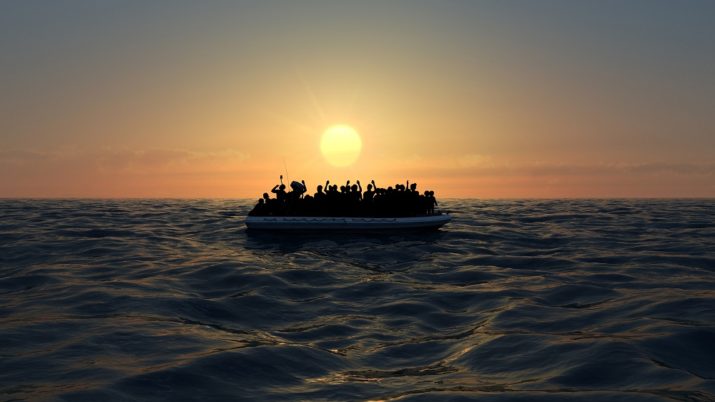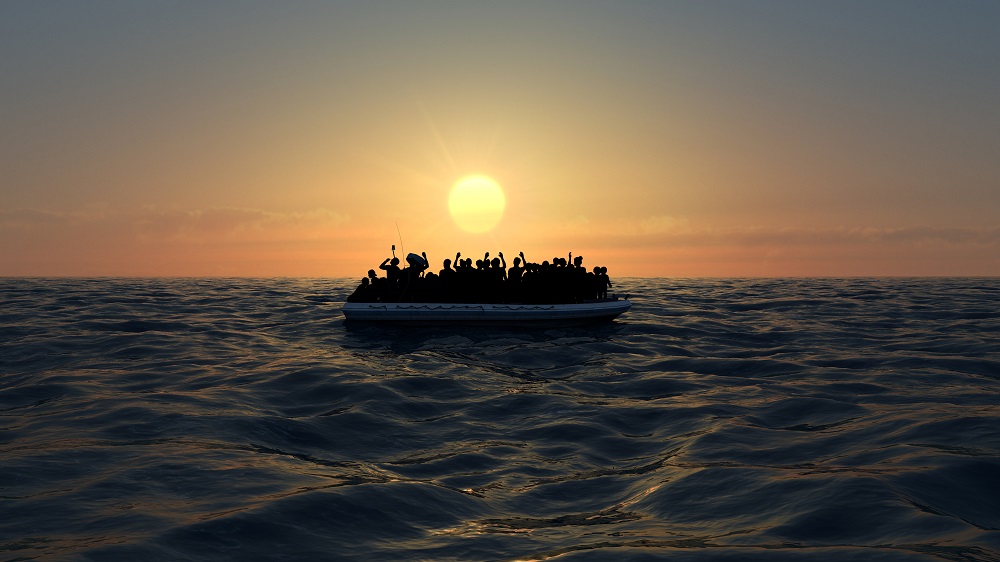

This is part of our Campus Spotlight on the Consortium on Forced Migration, Displacement, and Education (CFMDE).
Since 2015, more than three million people from the Middle East, Africa, and Asia have traveled into the European Union in order to seek refuge and asylum (Eurostat 1-3). Their arrival has prompted many state agencies, public commentators, and even migrants themselves to speak of a “refugee crisis”—or, alternatively, a “crisis of the state”—that threatens to undermine the EU’s regime of border regulation and overwhelm its members’ capacities for humanitarian care. As challenging as the current situation is, however, its characterization as a crisis is also somewhat curious. After all, this is hardly the first time that European nation-states have responded to large numbers of refugees and other migrants: tens of millions of displaced people traversed the continent during and after World War II (e.g., Cohen, Gatrell), while post-unification Germany, in particular, has contended with more than a million refugees from the collapsing Yugoslavia and ethnic Germans “returning” from the Soviet Union and Russia (e.g., Joppke, Molnar). At the same time, more people are currently seeking protection, whether as refugees or as “internally displaced people,” in countries like Turkey, Syria, the Democratic Republic of the Congo, and Colombia than in the entire EU (United Nations High Commissioner for Refugees 2, 3, and 33-37). And finally, most EU member states, despite decades of neoliberal restructuring and the ongoing impact of the recent recession, continue to have significantly greater material and institutional resources at their disposal than other major “receiving countries” worldwide. So what does it mean to speak of a European refugee crisis since the summer of 2015? Why declare an emergency now, and why locate that emergency in Europe?
My students and I set out to examine these questions in Confronting the “Crisis:” Refugees and Populism in Europe, a course which I taught twice in the 2017-2018 academic year. We did not take the empirical existence of a refugee crisis for granted, but instead sought to unpack the very notions of “refugee” and “crisis” as historical and political concepts. In the process, the students noted that “Europe” itself requires critical inquiry, especially given the frequency with which populist opponents of asylum and migration have invoked it. In the course of our discussions, it became clear that we could not comprehend contemporary refugee politics without also understanding the social conditions that have made populism—especially the variety that expresses a marked hostility toward migrants—so compelling to so many European citizens. Refugee mobility and populist mobilization, in other words, had to be placed within a common analytical frame.
The conversations were lively both times I taught the course: first on Bard’s main campus in Annandale-on-Hudson, New York in fall 2017, then at a campus of the Bard Prison Initiative (BPI) within Eastern NY Correctional Facility in spring 2018.[1] My students on the Annandale campus, twenty-two of them in all, were men and women between eighteen and twenty-two years of age. About two-thirds of them were members of the United States’ unmarked white majority, while the remaining one-third were of Hispanic, Middle Eastern, South Asian, or East Asian background. The seven students at Eastern, on the other hand, were men who ranged in age from their late twenties to their late thirties. Most were African-American, Asian-American, or Hispanic students, many of whom maintained ties with family in the Caribbean and East Asia. But there were also two students who defined themselves as white US natives. Of course, the students in both classes related to the course’s themes on the basis of their varied backgrounds: some could draw on firsthand experiences of migration, while for others migration was a matter of diffuse family memory and American national mythmaking. In the end, though, I was struck by the congruence of their intellectual, political, and personal engagement. Despite the divergent settings, the students were asking similar questions, making similar observations, and drawing similar connections with the American and global present.
In order to give the discussions in each class a common foundation, the students and I initially read a series of classic and recent texts that critically examine how refugees have been conceived, administered, and represented (Arendt 267-302, Gatrell 89-117, Malkki). We also read excerpts from several historically informed treatments of “crisis” and cognate notions like “exception” and “emergency” (Koselleck 358-361 and 368-377, Agamben 1-5, Schmitt 5-15). We then worked through a series of book-length case studies that trace patterns of mobility and enforcement in the Euro-African borderlands (Andersson), the politics of humanitarian care in France (Ticktin), and the governmental regulation of right-wing extremism in Germany (Shoshan). In keeping with my training as a cultural anthropologist, these studies devoted fine-grained attention to the biographical experiences of particular people and the lived effects of state interventions.
The course also contained several innovative pedagogical elements, many of which encouraged students to approach course themes in questioning, creative, and self-directed ways. At several points, I invited the students to interrogate visual images of refugees and the means by which those images are produced, circulated, and interpreted. In response to the United Nations High Commissioner for Refugees’ 2016 Global Trends report, for example, one Hispanic student at Eastern pointedly asked why so many of the refugees depicted in the report’s photographs were women and children of color (e.g., United Nations High Commissioner for Refugees 8 and 29). Did these images merely reflect the demographic composition of displaced people today? Or did they imply, in line with engrained preconceptions, that refugees are needy, vulnerable, helpless, and innocent? Did these images threaten to racialize not only refugees, but also the institutions and people who provide them aid? Meanwhile, in response to documentary films like Daphne Matziaraki’s 4.1 Miles and James Bluemel’s Exodus, a number of students in both classes wondered how the filmmakers selected the refugees and rescue workers who were the focus of the films’ attention. Were the filmmakers highlighting individuals whose stories they thought would be accessible and appealing to viewers? If so, what did those decisions suggest about the expectations of the filmmakers and the audiences they imagined for their work? Other students wondered about the intended and unintended consequences of portraying refugees’ privation during their travels. Did visceral footage of Mediterranean sea rescues, or treks across the Sahara in overcrowded pickups, inevitably elicit viewers’ empathy? Or could it inadvertently promote “compassion fatigue” by numbing viewers to refugees’ motivations and travails?
Perhaps the most unusual aspect of the course, however, was the “critical dictionary.” This assignment asked students to compose entries for a lexicon of key terms related to migration, refuge, and populism. The dictionary was “critical” in the sense that it encouraged students not simply to define those terms as they are commonly employed in scholarly and public discourse, but to reflect on their tacit or explicit premises, claims, and implications. What does a term like “refugee” suggest that “illegal immigrant,” for instance, does not? What kinds of institutional effort to promote, regulate, and/or deter mobility might that term sanction? What analytical insights and moral claims might its use both enable and foreclose? The students collectively generated a pool of terms and discussed the logic by which they would be organized. They also worked collaboratively in small groups to compose and revise clusters of ten to twelve entries around four topical loci: nationality/citizenship, crisis, migrants/refugees, and sovereignty/government/borders. In the end, the compiled dictionary, which ran to more than sixty pages, adopted a thematic rather than alphabetical logic, one that allowed students to examine the ways that terms resonated both with and against one another. In my role as editor, I opted to emphasize fruitful—at times messy—connectivity over seamless coherence: when multiple groups wrote about the same term, I did not direct them to compile their writing into a single entry or otherwise eliminate redundant material, but instead allowed the groups to explore how that term echoed and played in different semantic contexts. Overlaps and disjunctures were not flaws to be eliminated, but opportunities for further reflection.
The students put our written assignments and discussions to work for different purposes. In some cases, the students used them as occasions to examine a particularly dense set of ideas and claims from the assigned reading. What did authors like Hannah Arendt, Carl Schmitt, and Wendy Brown mean by “sovereignty?” To what extent do refugees constitute bare life in Agamben’s terms, and how might their management be a form of Foucauldian governmentality? In other instances, students used the dictionary and other assignments to engage in their own imaginative readings of migration-related discourse and practice. One Annandale student whose father works for UNCHR, for example, explained the algorithm by which the agency calculates the risk of a humanitarian emergency in a particular nation-state and thereby decides whether its intervention is necessary. She thereby uncovered the challenges, and the limits, of transforming complex social conditions into abstract quantities and calculations. Another Annandale student of Palestinian background, meanwhile, outlined the Arabic-language equivalents of our conventional migration-related vocabulary in English. In the process, she realized that the Arabic terms were often constructed from the same triliteral root that appears in Islamic concepts like hajj, hijra, and muhajirun.[2] This observation led her to reflect on the religious connotations that accompany the language of migration in Arabic but which are largely absent in English and other European languages. Finally, many students sought to relate our readings and discussions to recent events both within and outside the EU. The students at Eastern, for instance, dwelled on the moment when the players and coaches of Hertha Berlin protested racism in Europe by “taking a knee,” in the manner of Colin Kaepernick, before one of the team’s matches in 2017. Did this gesture constitute a meaningful expression of solidarity with Kaepernick and other National Football League players, or did it instead co-opt and dilute their protest against police brutality? One group of Annandale students, on the other hand, considered how some Hudson Valley residents had expressed their opposition to local refugee resettlement by associating displaced Syrians with terrorism and disease. Above all, though, many students were keen to engage with the anti-migrant positions recently articulated by US President Donald Trump.
Perhaps inevitably, both classes read, watched, spoke, and wrote with the 2016 presidential election and the first eighteen months of the Trump administration in mind. The Annandale students were particularly concerned with the implications and effects of the so-called “Muslim ban”: despite (if not because of) the security concerns that underlay Trump’s executive order, did the ban reductively cast citizens of the affected countries, if not Muslims more broadly, as civilizational others and moral inferiors? The students at Eastern, meanwhile, were particularly attentive to the “migrant caravan” that was then making its way from Honduras to the US border. On what possible grounds could this group of aspiring asylum applicants be said to threaten US sovereignty? Would the construction of a more imposing border wall actually deter migration, given the long history of mobility in the region and the enduring conditions that Central Americans were trying to flee? In both classes, the students were distressed by the Trump administration’s apparent disregard for the millions of Muslims and Central Americans who already live in the US as productive, law-abiding residents. As students insisted on multiple occasions, the Trump administration’s positions presumed a sharp distinction between a host of external dangers and a beleaguered national interior that could not withstand serious scrutiny. At the same time, students in both settings were upset by the administration’s readiness to overlook the US’s past and present role in these regions. Hadn’t the US cultivated economic and strategic partnerships with many of the very states that would be subject to the travel ban (as well as some states—including, most notably, Saudi Arabia—that would not)? Hadn’t US state and corporate involvement in Central America over the last century and more, as well as the federal government’s more recent deportation policies, contributed to the entrenched poverty, corruption, crime, and violence that people were now seeking to escape?
In my role as teacher, I worked to create an environment where these expressions of righteous indignation, with which I frankly sympathized, retained a solid intellectual foundation. I accordingly pushed the students in both classes to avoid mere editorializing and to relate their moral and political judgements to concepts, arguments, and approaches we had encountered in our readings. At the same time, I prompted the students to give serious thought to the reasons why anti-migrant populist arguments, including those advanced by the Trump administration, would be appealing at this particular moment. With this question in mind, we engaged with a number of readings that traced the economic dislocations (e.g., the complex impacts of neoliberal restructuring), political transformations (e.g., the collapse of state socialism), and cultural logics (e.g., recent Euroscepticism, but also enduring racial ideologies) that have fed into populist movements in Germany, Poland, and the United Kingdom over the past three decades (Holmes 3-16, Kalb, Steinmetz). In the process, we questioned the inclination to equate populist politics with voting constituencies that can be narrowly defined in terms of ethnicity/race, class, and gender. After all, anti-migrant populism hardly appeals to “white working-class men” alone, as the results of both the recent Brexit referendum and the US presidential election bear out (Gusterson).
By the end of the two classes, the students and I had reached a few basic conclusions. First, we recognized the pressing need to move beyond representations of refugees and other migrants as abject victims. In one way or another, most of our course materials underscored how people on the move actively interpret their circumstances, cultivate their aspirations, weigh their risks, marshal their resources, and strive to keep up their hopes amid uncertainty, boredom, and despair. They are not entirely at the mercy of their circumstances, even if that is how they are commonly portrayed in humanitarian, activist, and journalistic accounts. At the same time, our readings and discussions regularly highlighted the fact that refugees’ lives are embedded in larger structural contexts that do not merely condition their actions in decisive ways, but all too often confront them with dilemmas and double-binds that cannot be easily resolved. The students and I accordingly reflected at length on the concept of “agency,” and in a manner that sought to do justice to the nuance of refugees and other migrants’ lives. In the end, we did not reject the notion of agency outright, but we did decide that it is always situated and contingent.
Our second conclusion was that perceptions of crisis in contemporary Europe cannot be attributed merely to the sheer number of refugees, or to the burdens they purportedly place on states’ and citizens’ capacities for accommodation. Instead, these perceptions highlight lingering contradictions in “Europe” itself as a form of political organization and cultural self-definition. In particular, declarations of crisis tend to situate the EU as a seemingly insulated and self-contained zone while framing mass mobility as an external phenomenon that has only recently impinged on it. The discourse and practice of crisis thereby obscure the historical relationships that European actors have long maintained with societies and polities in Africa, the Middle East, and other parts of the Global South. It is only through these relationships, many of them rooted in colonial and imperial undertakings, that Europeans have been able to define “Europe” as enlightened, modern, secular-liberal, (Judeo-)Christian, feminist, and—tacitly or explicitly—white. In line with the thinking of Nicholas De Genova and other scholars, my students and I decided that “crisis” points to an entrenched difficulty in acknowledging and confronting these historical entanglements (De Genova, Hage).
Of course, if the recent declarations of a “humanitarian and security crisis” on the US-Mexico border are any indication, such entanglements are not restricted to Europe alone. They are just as present in the US, and just as deserving of concerted investigation and public action, as they are elsewhere. To be honest, this is where my students and I faced our most intractable difficulties: what is to be done now? Should nation-states in Europe, North America, and other parts of the world continue to regulate migration and access to refuge, or should they adopt some form of “open borders” policy that places fewer restrictions on people’s mobility? How can governmental and non-governmental actors assist displaced people in ways that do not inevitably relegate them to a position of dependency? And how, if at all, can we address the dispossession and suffering that prompt millions to move in the first place? Will more economic and political investment in the Global South necessarily need to less migration? My students and I did not arrive at any definitive answers to these questions, but I believe we did acquire a subtler understanding of the challenges that all of us—migrants and residents, newcomers and locals—must collectively face.
On this count, the students at Eastern were as committed to engaged citizenship as their counterparts in Annandale. I only wish they might enjoy the same opportunities to speak, vote, and otherwise contribute to democratic decision-making once they leave prison.
Click here to view Jeffrey Jurgens’s syllabus for Confronting the “Crisis:” Refugees and Populism in Europe.
Jeffrey Jurgens is Faculty Adviser to the Bachelor’s Degree Program in the Bard Prison Initiative and Visiting Assistant Professor in the Anthropology Program at Bard College. He specializes in topics related to migration, citizenship, and public memory among people of Turkish backgrounds in Berlin as well as the cultural politics of “crisis” in Germany and Europe. His publications have appeared in journals like Policy and Society, Transit, and Turkish-German Studies Yearbook as well as the edited volumes Different Germans, Many Germanies (2017) and Walls, Borders, Boundaries (2012).
References:
Agamben, Giorgio. State of Exception. Translated by Kevin Attell. Chicago: University of Chicago Press, 2005.
Andersson, Ruben. Illegality, Inc.: Clandestine Migration and the Business of Bordering Europe. Oakland: University of California Press, 2014.
Arendt, Hannah. The Origins of Totalitarianism. New York: Harcourt, Brace, and Jovanovich, 1973 [1951].
Bluemel, James. Exodus. London: Keo Films, 2016. pbs.org/wgbh/frontline/film/exodus/(accessed February 22, 2019).
Cohen, Gerard Daniel. In War’s Wake: Europe’s Displaced Persons in the Postwar Order. Oxford: Oxford University Press, 2012.
De Genova, Nicholas. “The European Question: Migration, Race, and Postcoloniality in Europe.” Social Text 34, no. 3 (September 2016): 75-102.
Eurostat. Statistics Explained: Asylum Statistics. Luxembourg: Eurostat, 2019. http://ec.europa.eu/eurostat/statistics-explained/index.php?title=Asylum_statistics (accessed December 17, 2018).
Gatrell, Peter. The Making of the Modern Refugee. Oxford: Oxford University Press, 2013.
Gusterson, Hugh. “From Brexit to Trump: Anthropology and the Rise of Nationalist Populism.” American Ethnologist 44, no. 2 (May 2017): 209-214.
Hage, Ghassan. “État de Siège: A Dying Domesticating Colonialism?” American Ethnologist 43, 49 1 (February 2016): 38-49.
Holmes, Douglas. Integral Europe: Fast-Capitalism, Multiculturalism, Neofascism. Princeton: Princeton University Press, 2000.
Joppke, Christian. Immigration and the Nation-State: The United States, Germany, and Great Britain. Oxford: Oxford University Press, 1999.
Kalb, Don. “Conversations with a Polish Populist: Tracing Hidden Histories of Globalization, Class, and Dispossession in Postsocialism (and Beyond).” American Ethnologist 36, no. 2 (May 2009): 207-223.
Koselleck, Reinhart. “Crisis.” Journal of the History of Ideas 67, no. 2 (April 2006): 357-400.
Malkki, Liisa H. “Speechless Emissaries: Refugees, Humanitarianism, and Dehistoricization.” Cultural Anthropology 11, no. 3 (August 1996): 377-404.
Matziaraki, Daphne. 4.1 Miles. New York: The New York Times, 2016.nytimes.com/2016/09/28/opinion/4-1-miles.html (accessed February 22, 2019).
Molnar, Christopher A. Memory, Politics, and Postwar Yugoslav Migrations to Germany. Bloomington: Indiana University Press, 2018.
Schmitt, Carl. Political Theology: Four Chapters on the Concept of Sovereignty. Translated by George Schwab. Chicago: University of Chicago Press, 2005.
Shoshan, Nitzan. The Management of Hate: Nation, Affect, and the Governance of Right-Wing Extremism in Germany. Princeton: Princeton University Press, 2016.
Steinmetz, George. “Social Class and the Reemergence of the Radical Right in Contemporary Germany.” In Reworking Class, edited by John R. Hall, 335-368. Ithaca: Cornell University Press, 1997.
Ticktin, Miriam. Casualties of Care: Immigration and the Politics of Humanitarianism in France. Berkeley: University of California Press, 2011.
United Nations High Commissioner for Refugees. Global Trends: Forced Displacement in 2017. New York: UNHCR, 2018. unhcr.org/globaltrends2017/ (accessed February 22, 2019).
United Nations High Commissioner for Refugees. Global Trends: Forced Displacement in 2016. New York: UNHCR, 2017. unhcr.org/globaltrends2016/ (accessed January 28, 2018).
[1] Eastern is a maximum-security men’s prison and one of six facilities where BPI offers liberal arts college degree programs. I teach regularly on both the Annandale and the prison campuses.
[2] Hajj refers to the pilgrimage to Mecca that Muslims strive to undertake as part of their religious obligations. Hijra refers to the journey of the Prophet Muhammad and his companions from Mecca to Medina in 622 CE. This event, not the onset of the Prophet’s revelations, marks the beginning of the Islamic hijiri calendar. Finally, muhajirun refers to the Prophet’s companions, though it could also be aptly translated as “migrants” or “pilgrims.”
Photo: Refugees on a big rubber boat in the middle of the sea | Shutterstock
Published on March 5, 2019.




